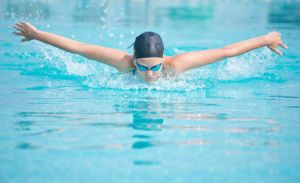
Swimming is one of the best total body workouts. It is a great cardio activity and also helps to build and preserve muscle mass throughout the body in addition to being a low-impact exercise with little risk of injury.
The pool is a great place to find relief for stiff muscles and sore joints, particularly for those who are overweight or suffer from arthritis.
Swimming allows you to work more of your body at once. For example, using a piece of gym equipment like a bicep curl machine only works one part of the body, while swimming engages the arms, hips, legs, and spine. When lengthening your body through the water by reaching forward, it even gives you a great full-body stretch.
The activity doesn’t just tone the muscles you can see, such as the quads and pecs, it also helps to improve a very important muscle: the heart. Swimming helps to strengthen it and also make it more efficient which can improve blood flow throughout the body.
It is also one of the best calorie-burning exercises to help boost your weight loss efforts or to maintain an ideal weight – all without the sticky, sweaty body feel of a traditional workout.
Starting a swimming program
If you don’t know how to swim, lessons are a must. Check with your local community pool or search for a program through U.S. Masters Swimming at www.usms.org. Even if you are an experienced swimmer, working with an instructor can help improve your form which can make a significant difference in how effective it is.
A good swimming workout is best started with the freestyle stroke. Just swim for as long as you can and then rest as needed, repeating for at least 20 minutes. Don’t compare yourself to others, remember swimming can be a tough workout and better endurance and stamina comes with time.
Work on your form
Your form is important; the head, hips and feet should form one straight line. Don’t allow your middle to sag or your feet to be too low as it will slow you down and drain your energy. If your feet tend to drag, try pushing your head down a little. Strengthening your core outside of the pool can help if your midsection tends to slump.
Your body should be elongated with each stroke. Keep your arm in line with or just inside your shoulder on each stroke. Don’t allow your arm to cross the midline of the body when moving through the water.
Practice, practice, practice
Initially you may want to get your body used to swimming by taking part in the activity regularly over the first few weeks to give it time to adapt. Give yourself ten sessions of fairly easy, steady swimming and then you’ll be ready to begin swim workouts.
For a swim workout, warm up first and then swim a variety of distances at varying paces, resting in between. By swimming faster laps you can help build your endurance and improve cardiovascular fitness. There are practically an endless number of workouts that you can try.
This routine is frequently offered for beginning swimmers:
Warm up with an easy 10-minute swim. Then swim one or two lengths of the pool at a faster pace and rest for 10 to 15 seconds. Repeat for 10 minutes.
 Perform intervals by swimming 100 meters, or two laps in a 50-meter pool, continuously at a speed that seems difficult but still manageable. Rest for 20 seconds; repeat 15 times. Your goal should be to swim three times a week and no less than twice in order to improve stamina and endurance.
Perform intervals by swimming 100 meters, or two laps in a 50-meter pool, continuously at a speed that seems difficult but still manageable. Rest for 20 seconds; repeat 15 times. Your goal should be to swim three times a week and no less than twice in order to improve stamina and endurance.
Remember that swimming takes longer to adapt to than other sports as your body has to acclimatize to new breathing patterns in addition to the weightlessness of being in the water. As this is such a great workout, it’s well-worth the efforts to reap the many rewards.
-The Atlernative Daily

